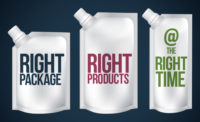Kleenex® Anti-Viral: Getting it Right the Second Time
![]()
Kleenex® Anti-Viral: Getting it Right the Second Time
Kleenex’s second attempt at “anti-viral” tissues makes better use of packaging to communicate its message.
by Robert Mcmath
Around December 1984, Kimberly-Clark introduced Avert by Kleenex®. In a rectangular blue and white striped box with a punch-out center for opening and removing the tissues, it was prominently identified with “Virucidal Tissues” and “Kills major cold viruses” copy in smaller print. The package was similar in size and overall general presentation to a regular facial tissue package, although in this case, instead of 100 tissues, there were only 60 three-ply tissues in the Avert package.
The company could have benefited from big-picture thinking. Words that end in “cidal”—homicidal, suicidal, patricidal—do not put people in a buying mood. And in the minds of consumers, the display panel on the package did not readily make it clear what a “virucidal” tissue was.
Fast forward to 2004, with the recent introduction of Kleenex Anti-Viral® Brand Tissues. The 60-count three-ply square box of tissues features a plastic over-band wrap that prominently displays the explanation “Kills 99.9% of Cold & Flu Viruses”. Fundamentally this time around, the company may have gotten the package right, as well as rectifying some other problems the first package/product had, which contributed to its initial failure in the market.
In the first package, the tissues were impregnated with the active ingredient to kill the bugs and help keep people from spreading it around. It was not intended to cure your cold, nor is the new product release. But the tissues in the first product introduction were indistinguishable from any other Kleenex tissue designed to remove cold cream, remove eye make-up, or stem a runny nose. Placed side by side out of the box, the consumer could not tell which tissue was which!
This time, in addition to more gently informing the consumer what the new product is about in less threatening terms on the package, the tissues themselves have two soft layers surrounding an inner impregnated layer. The inner layers exhibits dots the consumer can see through the outer layers. This design clearly makes the Anti-Viral tissues different from regular Kleenex tissues—or any other tissue currently on the market for that matter.
So, two of the product’s major faults have been addressed in this second presentation. “Anti-viral” seems to be a concept that consumers understand these days, ever since hand-washing lotions and other wet- and dry-application products for hands entered the market several years ago as “anti-bacterial”. In many cases consumers do not differentiate between bacterial and viral, and something to kill them is no longer a strange concept or one to be generally feared!
Clearly, people need to be educated. And perhaps there is no better place to do so than in schools. The number one target for cold remedy and treatment products is, after all, schoolchildren. And teachers, even more than parents, dread infectious diseases. Hopefully Kimberly-Clark will place a box of the Kleenex Anti-Viral on every teacher’s desk in schools that will permit the product to be distributed. And to go along with the box for the teachers’ desk, the company might consider sending home with every school child in America a small pocket-pack of Anti-Viral tissues and a pamphlet explaining its benefits. BP
The author, Robert McMath, has been a marketing consultant for more than 30 years. Through his NewProductWorks, he has advised major companies. He is the author of What Were They Thinking, a book chronicling the whys of product successes and failures.
Contact him at 607.582.6125 or rmcmath@cs.com. Visit the Internet site: www.NewProductWorks.com
Looking for a reprint of this article?
From high-res PDFs to custom plaques, order your copy today!







